Buri Daikon (Simmered Yellowtail and Daikon) is a classic Japanese wintertime favorite when both ingredients are in season and at their freshest. Cooked gently in a soy-infused broth, the homey flavors of this traditional fish dish are utterly comforting!
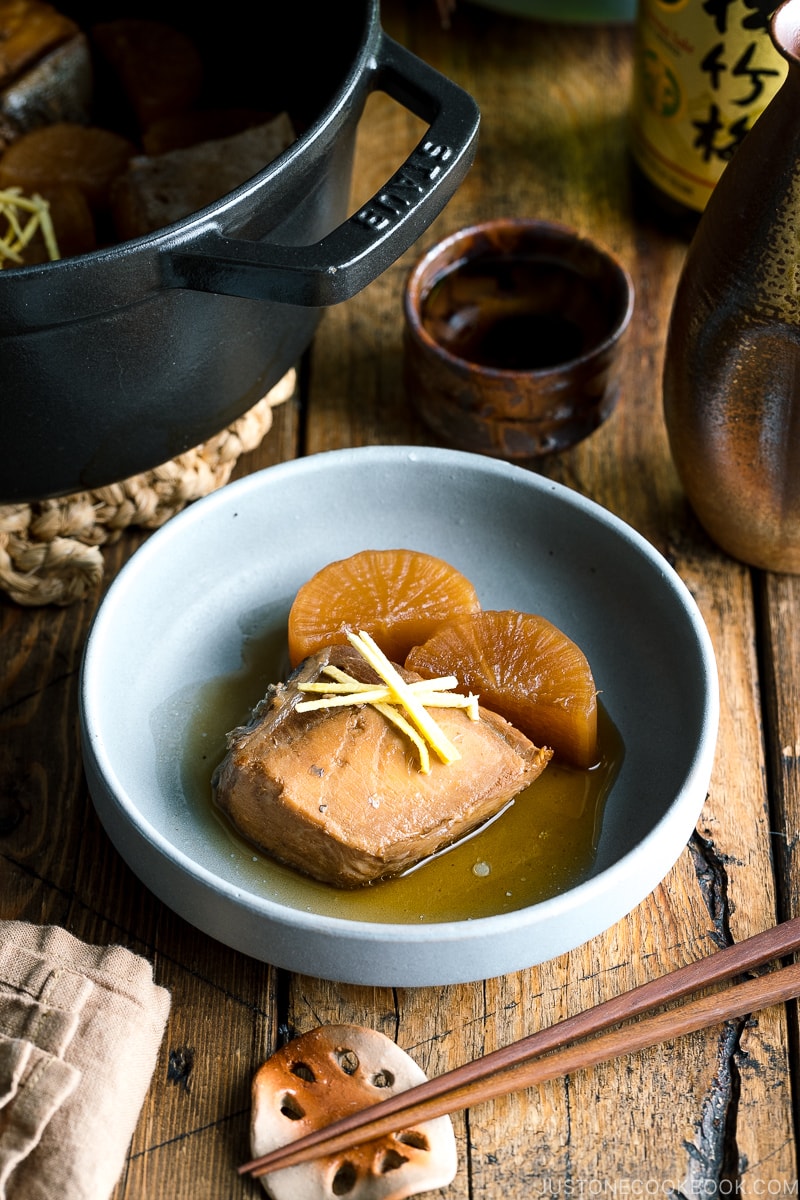
Living in California with a mild climate year round, I sometimes forget that instinctual desire to eat seasonal dishes that are truly special in Japan. So I am thankful when readers send in their requests and remind me of a specific food that I have not made for quite some time.
Today I’m sharing one of my old winter favorites, Buri Daikon (ブリ大根), or Simmered Yellowtail and Daikon.
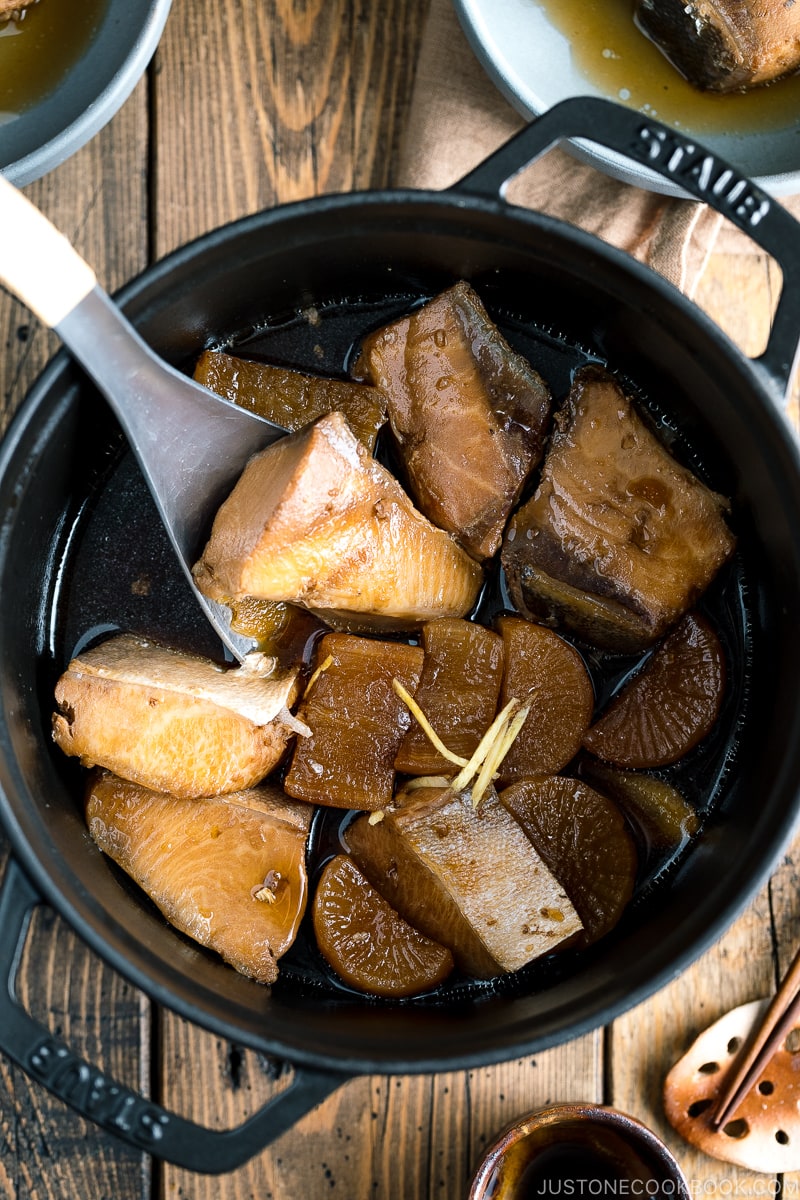
What is Buri Daikon
Buri Daikon (ブリ大根) is a simmered dish featuring yellowtail and daikon. Both ingredients are in season during the cold months. The combination of tasty, fatty yellowtail and juicy, sweet daikon radish works amazingly well in soy-infused broth.
This classic dish represents the taste of Japanese home cooking. With fresh, seasonal ingredients, it’s easy to achieve perfectly cooked dish.
Quick Overview of The Dish
- Flavor: Just like most typical simmered foods, Buri Daikon is seasoned with soy sauce, sake, mirin, and sugar. One major difference is that it does not use dashi (Japanese soup stock). Since yellowtail already packs in a lot of deep flavor, we can keep the broth simple.
- Ease: Before simmering the yellowtail and daikon, there are a few necessary steps involved. They enforce a clean, delicate taste of the final dish. More about it later.
- Simmering: The actual simmering time takes only 15-20 minutes. But we’ll let the dish cool down slowly so it develops an enhanced and richer taste.
Learn about Buri (Yellowtail)
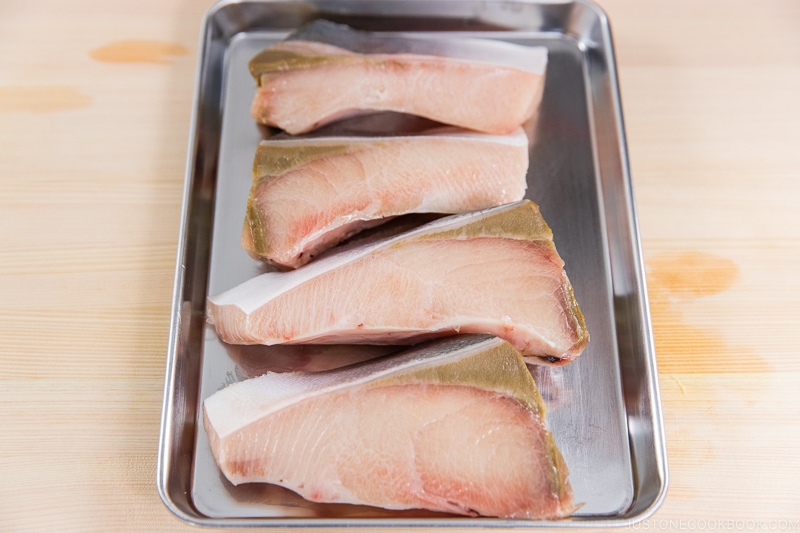
The Japanese love seafood, so we can get very serious and detailed with our naming. A good example is a yellowtail – a fish that changes names as it grows!
Traditionally, there were different names for wild yellowtail, according to size and age, and to make things more complicated, there were also different names between Tokyo and Osaka.
Age (Length) – Tokyo Name / Osaka Name
- 6 months (10 cm) – Wakashi / Tsubasu
- 1 year (30 cm) – Inada / Hamachi
- 3 years (60 cm) – Warasa / Mejiro
- 4 years (90 cm) – Buri / Buri
These days it’s even more confusing as the Japanese differentiate yellowtail by:
- Farm (small) – Hamachi (fatty with soft muscles due to less movement and lighter colored flesh)
- Wild (small) – Hamachi (firmer flesh and darker color)
- Wild (large) – Buri
When you’re eating out or shopping, remember the yellowtail “Hamachi” used for sushi and sashimi in the US and Japan is farmed. The larger, older, wild yellowtail “Buri” is caught in the fall in the Japan Sea.
During fall/winter time in Japan, seasonal Buri is called Kanburi (寒鰤) and it is nice and fatty, and has so much flavor.
Substitutions for Yellowtail (Buri)
For those who can’t get yellowtail (hamachi/buri) locally, here are my suggestion for substations. Make sure to use fillets with skin-on so that the fish will not disintegrate while cooking.
- Amberjack
- Cod
- Flounder/Sole
- Japanese butterfish
- Mackerel
- Salmon
- Sea bream
Learn about Daikon
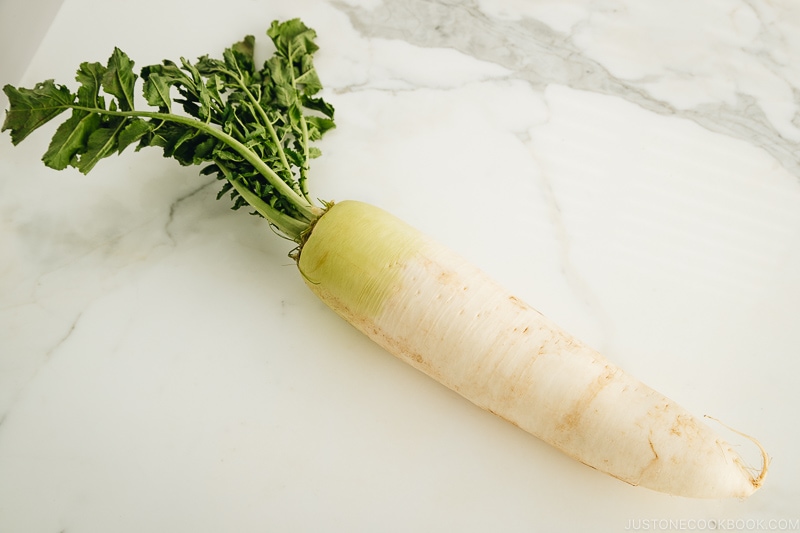
Daikon or daikon radish is a widely-used root vegetable in Japanese cooking. This winter vegetable is characterized by its long white root and green leaves on top, resembling a pale chunky carrot.
In the US, you can find daikon being sold at Japanese or Asian grocery stores, or any well-stocked major grocery stores like Whole Foods or Walmart.
Interested to learn more? Visit our Pantry page.
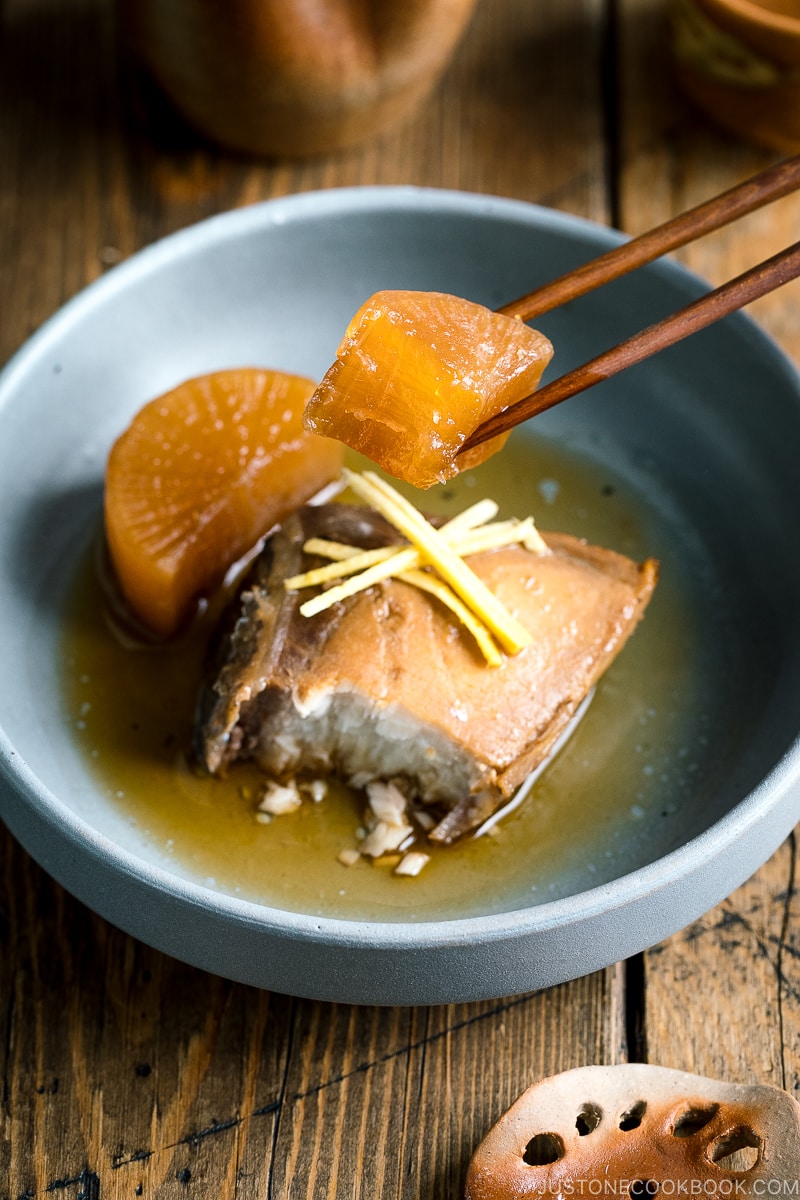
How to Cook Buri Daikon
4 Simple Ingredients
- Buri (Yellowtail)
- Daikon
- Ginger
- Condiments: soy sauce, sake, mirin, and sugar
Cooking Process Overview
- Cook daikon till tender.
- Blanch yellowtail.
- Simmer yellowtail and daikon in a seasoned broth.
- Slowly let cool, giving ingredients time to absorb flavors.
- Reheat and enjoy!
Tip 1: Cook Daikon with Rice Water
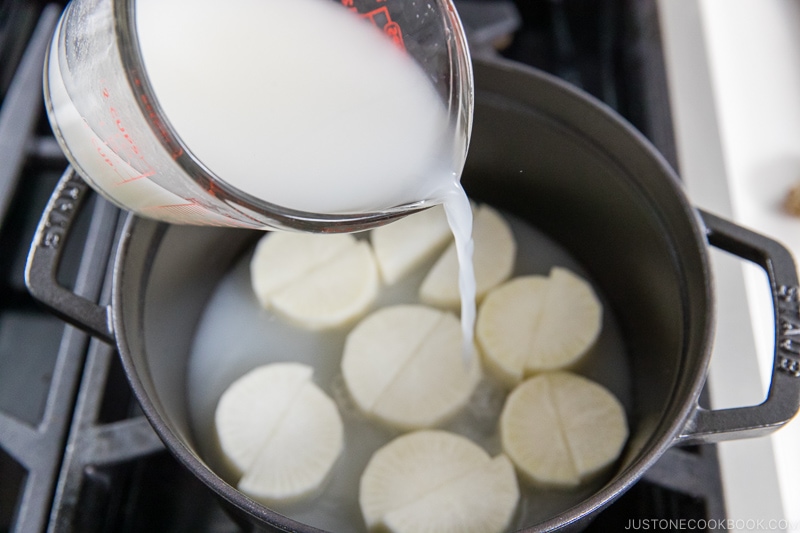
- The rice water helps to break down the texture of daikon due to the result of the catalytic activity of enzymes.
- Daikon becomes white by the action of enzymes.
- Starch also helps retain the shape of daikon (less likely to break).
- The bran absorbs the astringency of the daikon.
Tip 2: Let Simmered Food Cool After Cooking
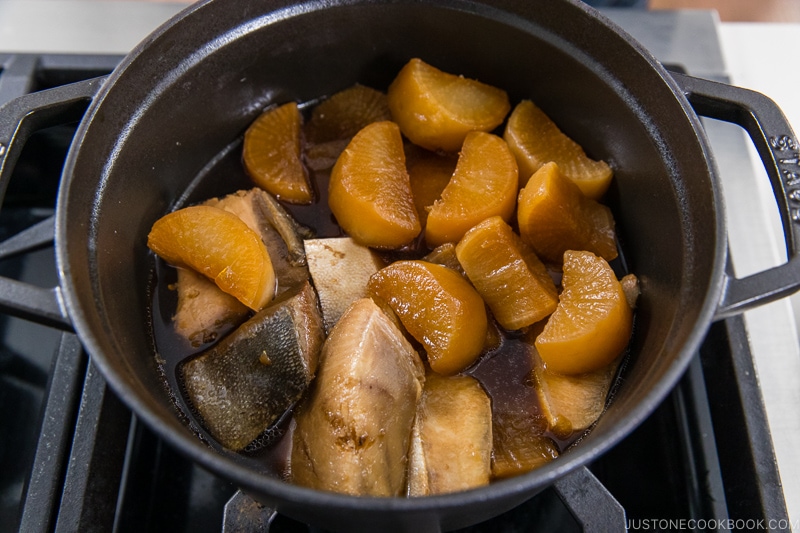
When food is being heated, the moisture of the food is removed from it. While the food is being cooled, the moisture gets absorbed back into the food along with the flavors.
This is why many simmered foods and stews like Nikujaga and Oden taste better the following day.
If time allows, make a simmered food ahead of time and let it cool slowly giving some time for the food to absorb all the delicious taste.
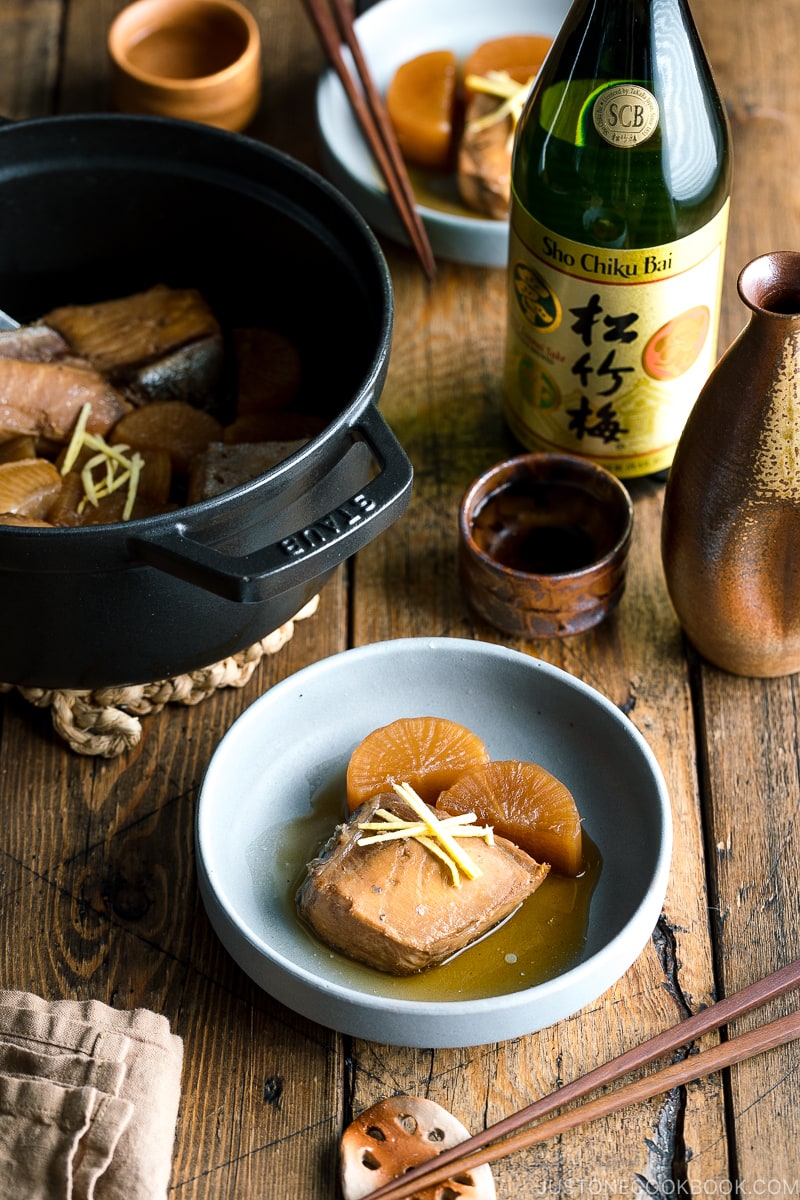
Pairing Buri Daikon with Classic Junmai Sake Sho Chiku Bai
It is tricky to pair seafood with alcoholic beverages. It’s usually suggested with white wines but the wine could be too dry or too sweet, and the flavor could conflict or overpower the dish. What we find is that the versatile sake pairs extremely well with many types of food including seafood.
For this classic Japanese dish buri daikon, we paired it with Sho Chiku Bai Classic Junmai. It’s our favorite sake to cook with but this award-winning sake is fantastic for drinking. The sake’s profile is very well-rounded and balanced, and it can be enjoyed either warm or cold depending on your mood. For buri daikon, since it’s a winter dish we heated up the sake to 113°F/45°C (read how to warm up sake properly).
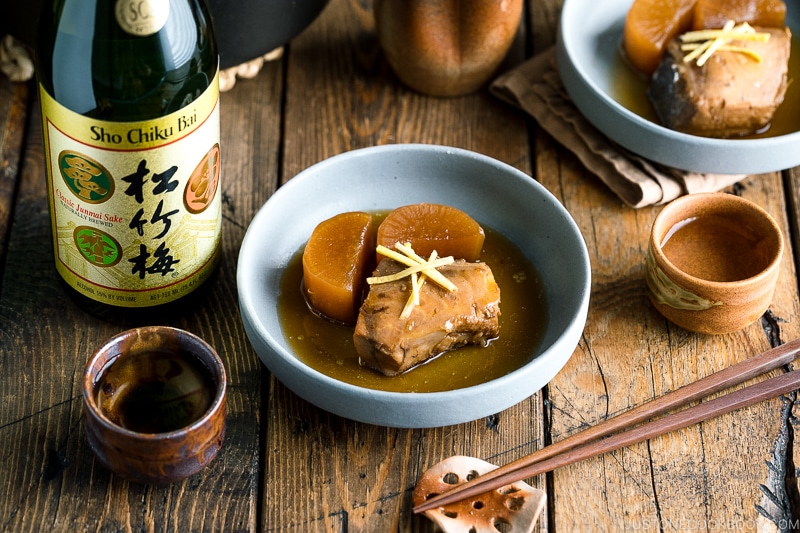
The buri and daikon had been absorbing the sauce for hours so the flavor is very strong. The pairing sake should be intense as well so they go together.
When Sho Chiku Bai Classic Junmai is warmed, more flavors are released compared to cold and both the taste and aroma become more robust. The first taste is peppery and sharp, with bold flavors leap at your palates. The strong flavors then subside and transition to a clean soft floral and sweet finish. It was a really good pairing and we highly recommend Sho Chiku Bai Classic Junmai for other seafood dishes.
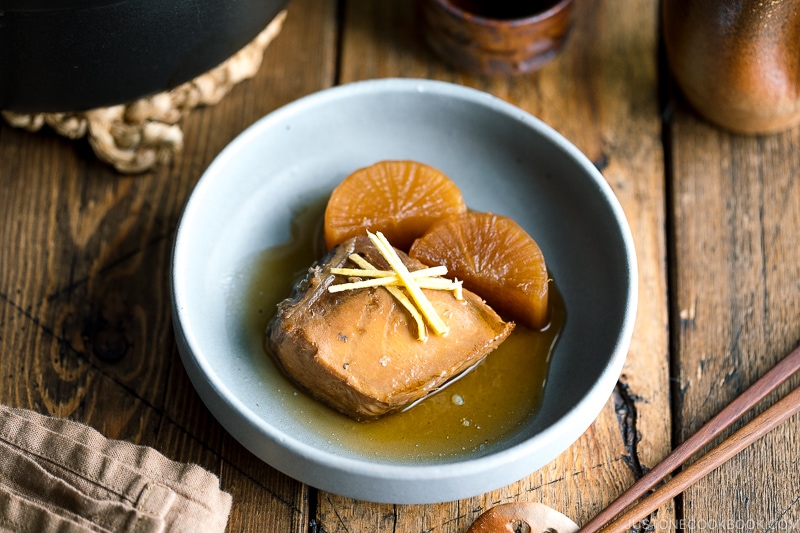
Wish to learn more about Japanese cooking? Sign up for our free newsletter to receive cooking tips & recipe updates! And stay in touch with me on Facebook, Pinterest, YouTube, and Instagram.
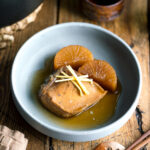
Buri Daikon (Simmered Yellowtail and Daikon)
Ingredients
- 1 lb daikon radish (6 inches, 15 cm)
- 1 lb yellowtail (hamachi, buri) (4 fillets from a Japanese grocery store; use skin-on fillets so they won‘t break easily; you could substitute amberjack, cod, flounder/sole, Japanese butterfish, mackerel, salmon, or sea bream)
- ½ tsp Diamond Crystal kosher salt
- 1 Tbsp sake
- 2 knobs ginger (2 inches, 5 cm total)
Instructions
- Before You Start…Please note that this recipe requires 2 hours of cooling time.Gather all the ingredients.
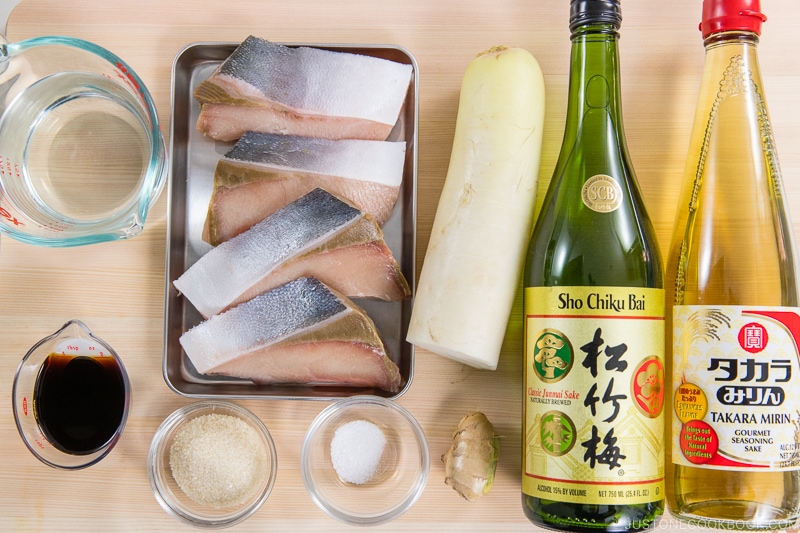
To Precook the Daikon
- Cut 1 lb daikon radish into ¾ inch (2 cm) rounds. Cut them in half if your daikon is more than 2 inches in diameter.
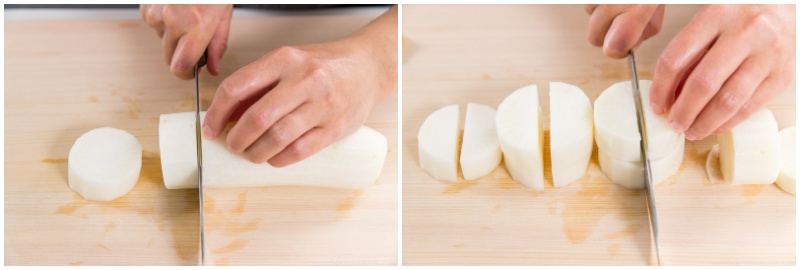
- In a medium pot (I use the 2.75 QT Staub), add the daikon and just enough water to cover it (about 2 cups/480 ml). In Japan, we use white rice water (from rinsing rice) to cook daikon. It’s believed that the rice bran from the rice water help reduce the bitterness.
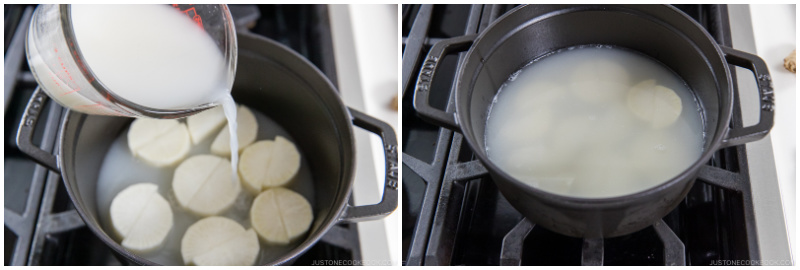
- Cook the daikon on medium heat for 15 minutes, until a bamboo skewer goes through smoothly. While cooking the daikon, prepare the rest of the ingredients.
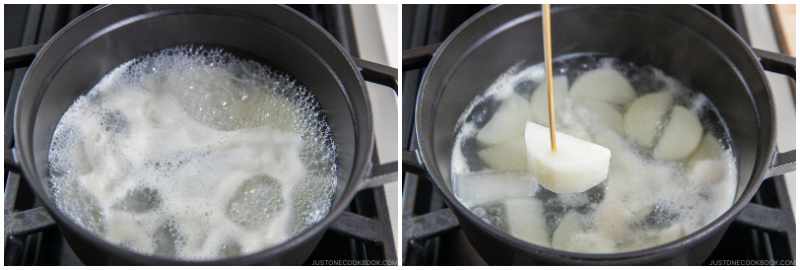
- Drain the water and rinse under cold water to remove the rice bran. Quickly rinse the pot as we will use it for simmering.
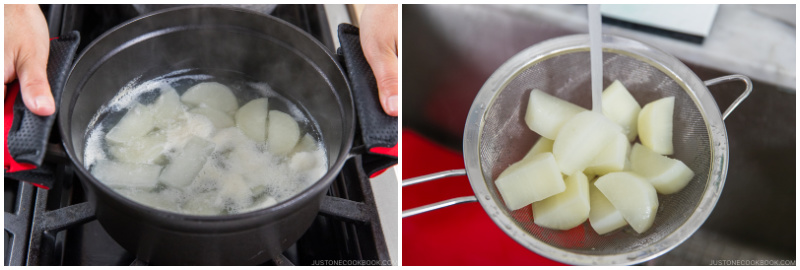
To Prepare the Ingredients
- While cooking the daikon, peel 2 knobs ginger and slice thinly. Save two-thirds of the sliced ginger for cooking. Julienne the other one-third of the ginger slices for garnish and set aside.
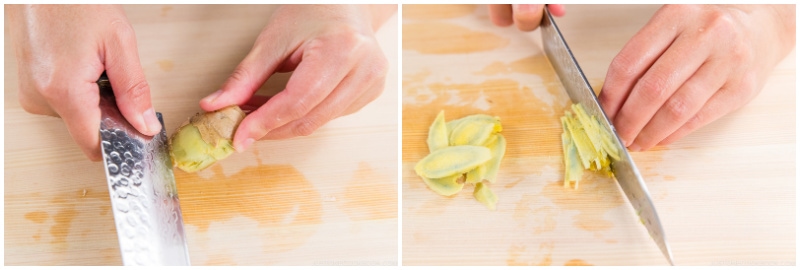
- Sprinkle ½ tsp Diamond Crystal kosher salt on both sides of 1 lb yellowtail (hamachi, buri), including the skin. Let it stand for 5 minutes, and then cut in half, about 2-inch (5 cm) pieces.
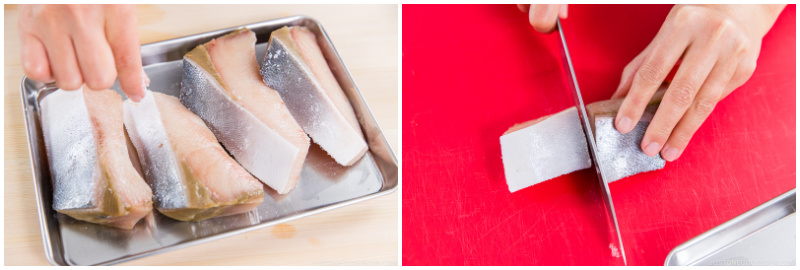
- Bring a medium pot of water to a boil. Once boiling, add 1 Tbsp sake. Then add in a few pieces of yellowtail. Cook until the surface of the fish turns white, about 10–15 seconds.
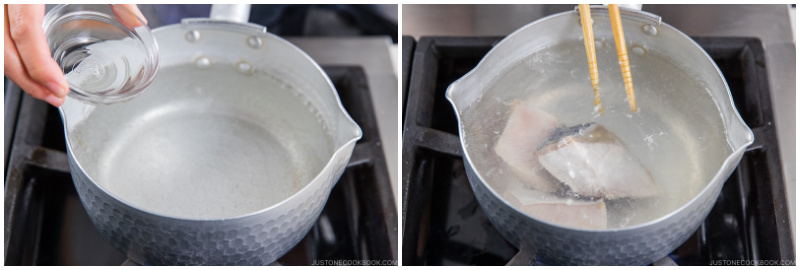
- Take the fish out and place the pieces in iced water. Once cooled, about 10 seconds, remove the fish from the iced water and transfer them to a plate/tray lined with a paper towel.
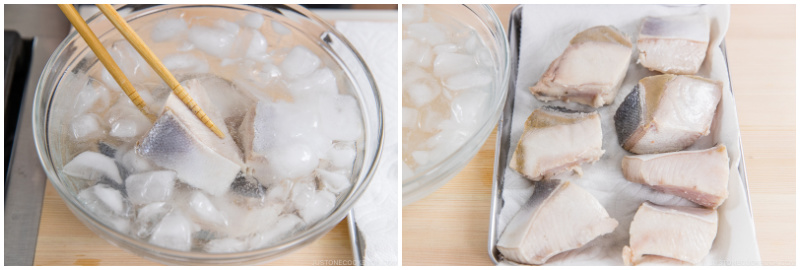
To Simmer the Buri Daikon
- In the medium pot (that you used for boiling the daikon), combine 1 cup water, 3 Tbsp sake, 3 Tbsp mirin, and 4 Tbsp soy sauce.
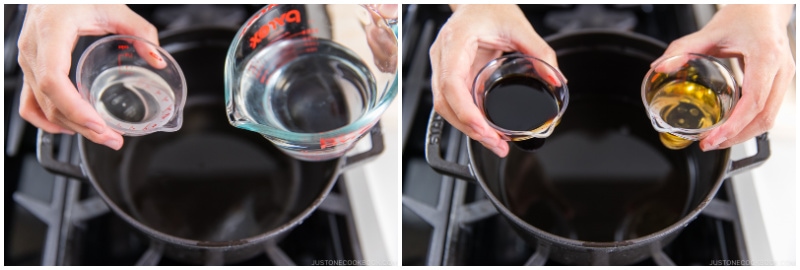
- Add the ginger slices and 2 Tbsp sugar. Mix it all together.
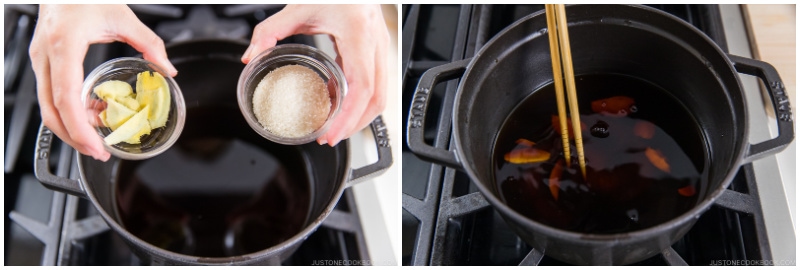
- Add the yellowtail and bring it to a simmer. Using a fine-mesh sieve, skim the scum and foam if there is any (there should not be much thanks to precooking).
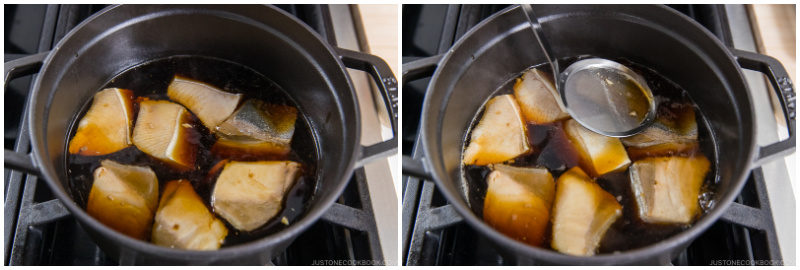
- Add the daikon and coat well with the seasoned broth. Keep it at a bare simmer.
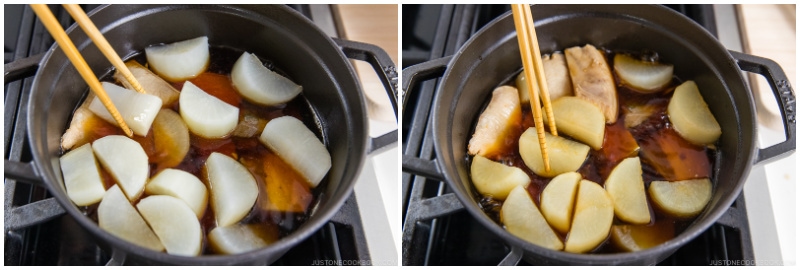
- Once simmering, place an otoshibuta (drop lid) (you can get one on Amazon) over the daikon and keep it at a bare simmer for the next 15 minutes, flipping the daikon occasionally. Do not use a regular lid because we need some moisture to escape and the otoshibuta helps to coat the daikon with seasoned broth at all times as it is always touching the food. Tip: You can make a homemade otoshibuta with aluminum foil.
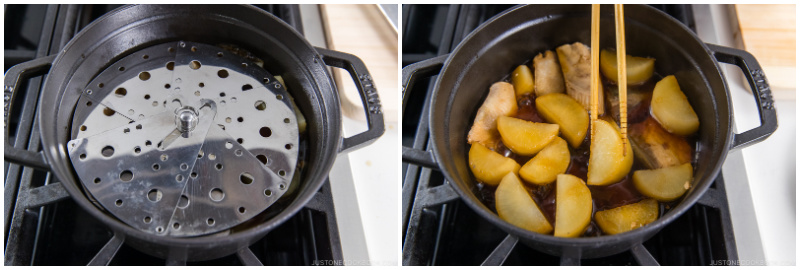
- About 15 minutes later, the dish is done cooking. You can serve it immediately; however, as I explained in the blog post, I highly recommend to let it cool even for a few hours.
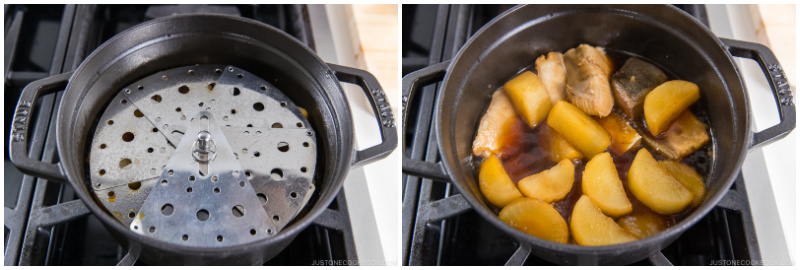
- Remove from the heat and let cool, keeping the otoshibuta on so the surface won’t dry out. Don’t use a regular lid as the foods take a longer time to cool. Once every 30 minutes or so, tilt the pot to coat the surface of the daikon with the seasoned broth.
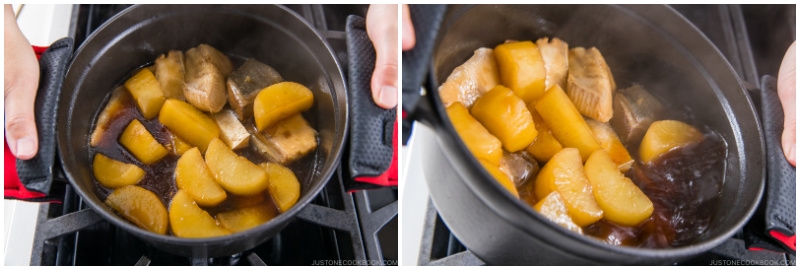
- Once completely cooled, you can refrigerate (especially overnight). Right before you serve, reheat until the dish is warm.

- Serve the dish in a bowl with some broth. Top the fish with julienned ginger. Enjoy!
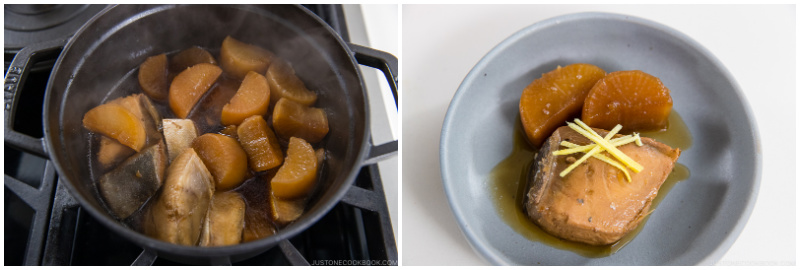
To Store
- You can keep the leftovers in an airtight container and store in the refrigerator for up to 2–3 days or in the freezer for up to a month.
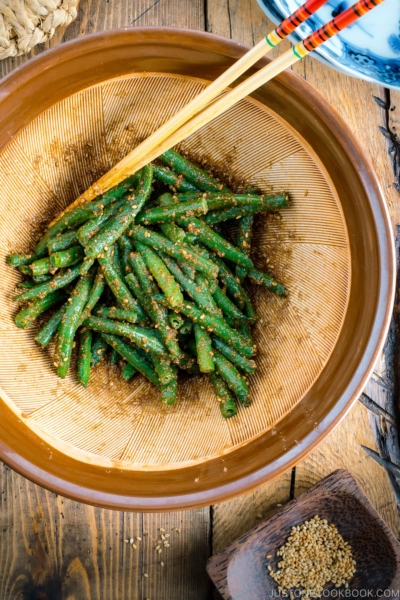

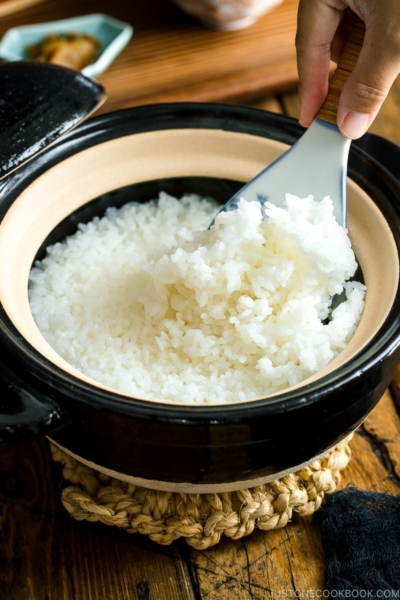
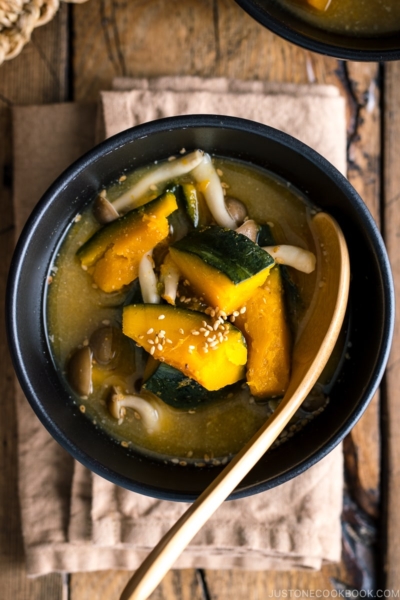




I’ve made this a few times now. Sea bass isn’t usually available near me/is over priced, so I’ve been testing with salmon and other recommend fish. I haven’t succeeded yet in not overcooking the fish, but it never detracts from how good it is. It’s now my go to recipe when I’m recovering from an upset stomach. Something about the bitterness of the daikon and the sweet/ umami from the sauce pairs so well with it and calms my stomach down. If I didn’t know better I’d eat an entire pot by myself it’s SO comforting.
Hello Jessica! We are glad to hear that this dish has become your healing dish.
Thank you for trying Nami’s recipe and sharing your experience; it’s truly remarkable!
Hi Nami,
Thanks for another wonderful recipe! I’ve learnt so much about japanese cooking and food through your work! 🙏 Thank you!
I just made this recipe tonight, I used tuna instead of yellowtail and it was delicious but now I have about half of it leftover. Since I’m going away, is it ok to freeze it?
Hi Patty! Thank you so much for trying Nami’s recipe!
You can keep the leftovers in an airtight container and store them in the freezer for up to a month.
We hope this helps!
Hi Naomi & team,
I don’t often get access to daikon where I am. Do you think regular radish would work? Maybe add in some carrots for sweetness? Funnily enough I have a hunk of frozen tuna that I’m thinking of using for this recipe, though I don’t think it has any skin. Also open to other ideas! LOVE your site and recipes xoxo
Hi evs, Thank you very much for reading Nami’s post and trying her recipes.
The regular radish could be more bitter than Daikon, but it should work in your situation. The key to this recipe is finding the right balance of soy sauce and sugar flavor. So please feel free to adjust the condiment amount to fit your ingredients.
We hope this helps!
Can I omit the Buri and just have the daikon as a side dish?
Hi Shay, Thank you for reading Nami’s post and trying her recipe!
Yes, you can just cook Daikon. However, we recommend using Dashi instead of water.😊
We hope this helps!
Thank you very much!
You are welcome, Shay! We hope you enjoyed the dish. 😊
Can this be made in an instant pot?
Hi Andrea! Thank you very much for reading Nami’s post!
Yes, this can be cooked in an instant pot. Cook in the high pressure for about 7~10 minutes and natural release.
We hope this helps!
Made this for dinner today and it was delicious! I will try this again with other fish like salmon which is cheaper and easier to get in compared to buri.
I would, however, like to confirm is the quantity of water required for the seasoning indeed 240 ml? I put all the ingredients for the seasoning then the fish but the liquid barely covered the fish so I decided to add more water. Even then, after simmering, there was hardly any sauce. I did use an otoshibuta made from aluminum foil.
Hi Jessica, Thank you very much for trying JOC recipes and for your kind feedback!
Yes. The water amount is 240 ml for this recipe, and the seasoning should barely cover the daikon and fish (Step 12 photo). Nami’s pot is medium size (the 2.75 QT Staub), so if you use a larger size pot, you may add more water and seasoning as you like. We hope this helps!
Hi Nami, I made ブリ大根 with salmon. It was delicious!
Hi Barbara! We are so happy to hear you enjoyed this recipe with salmon!
Thank you very much for trying Nami’s recipe and sharing your cooking experience with us.🙂
Can I use black cod (sablefish) collar for this recipe? I have a freezer drawer full of it from my mom and am looking for ways to use it.
Hi Ann, Sure, you can use a sablefish collar for this recipe. Enjoy!
Thank you so much for publishing this recipe, Nami. It looks like a superior version compared to the one I’ve been using!
Hi Robin, Thank you very much for your kind feedback!
We hope you enjoyed Nami’s many tips. 🙂
Great recipe! I was wondering if precooking the fish was really necessary? And do I still need to discard daikon water if I use plain water? Just trying to make it simpler for busy nights 🙂
Hi Muslima, It takes a little time, but a delicate dish like this, we prefer precooking the fish to prevent the unwanted smell from fish. And we preboil the daikon and discard the water. It’s an important step for the fine dish.🙂
Luckily we have a Japanese grocery store not far from us and I found lovely pieces of yellowtail! This recipe is outstanding!! My husband has traveled to Japan many times on business. He commented as he walked into the kitchen while it was cooking, “It smells just like a Japanese restaurant in here!” I’ve made it twice now and it will be made many more times! I may try a different fish, but the yellowtail was wonderful!
Hi Cheryl! We are glad to know that you and your husband enjoyed Buri Daikon!
Nami and JOC love the comment, “It smells just like a Japanese restaurant.”😁
Thank you very much for trying this recipe and for your kind feedback! Happy Cooking!
Hi Nami-san,
This is a great dish since I love both buri/hamachi and daikon! I checked your separate blog on Daikon and it was funny to find out that daikon is part of the radish family and not turnip as I had believed all these many years!!! Whatever, it’s very good and like you said, so versatile and wonderful.
Hi Dan, Thank you very much for reading Nami’s post and trying her recipe!🙂
Yours is a wonderful site! I’m really enjoying it thank you so much for the content. Your recipes are clear and informative and I appreciate the in depth detail about ingredients. With thanks from the UK.
Hi Jill! Aww… Thank you very much for your kind feedback from the UK! You have no idea how much your kind words meant to us! Nami is happy to read your comment. 😊
What fish can I use instead of buri? We do not have it around here.
Hi Tatiana! Thank you for trying this recipe!
Most skin-on fillets should work well for this recipe, and we have posted the substitution ideas next to the ingredient. We hope this helps!😊
Hi, Nami! Can you make this same dish using salmon or another kind of fish if unable to find buri?
Hi Karen! Thank you very much for asking this question!
Yes, you can use salmon and another kind of fish instead of Buri. Nami updated the post with substitution ideas. We hope this is helpful!😊